
|
It brightened up to 6.0 mag in mid May (May 14, Chris Wyatt). It will be fading after this. But it is bright as 6.6 mag still now (May 23, Rob Kaufman). In the Southern Hemisphere, it keeps observable in good condition until late June. In the Northern Hemisphere, it keeps unobservable until September when the comet will be fainter than 13 mag.
Date(TT) R.A. (2000) Decl. Delta r Elong. m1 Best Time(A, h)
May 23 6 18.36 -16 6.2 0.639 0.780 50 6.4 20:43 ( 80,-13)
May 30 7 7.00 -7 1.4 0.864 0.789 48 7.2 20:50 ( 86, -6)
|

|
It brightened up to 3.7 mag and became a naked eye comet in mid January (Jan. 13, Marek Biely). Now it is fading. But it is bright as 7.9 mag still now (May 23, Neil Norman). In the Northern Hemisphere, it keeps observable all night until July when the comet will fade down to 10 mag. Then it keeps observable for a long time until the comet fades out. It is not observable in the Southern Hemisphere.
Date(TT) R.A. (2000) Decl. Delta r Elong. m1 Best Time(A, h)
May 23 0 56.11 86 31.3 2.244 2.073 67 8.0 3:10 (184, 35)
May 30 20 9.82 89 2.0 2.291 2.145 68 8.2 3:05 (180, 36)
|
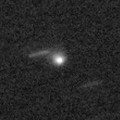
|
Now it is 11.6 mag (May 16, Michael Mattiazzo). It will approach to the sun down to 0.3 a.u. in July, and it is expected to brighten up to 3 mag. However, it is fainter than predicted recently. In the Southern Hemisphere, it is observable in the extremely low sky until early June. Then it becomes unobservable temporarily, but it will be observable after mid July, and keeps observable while the comet will be fading gradually. It will not be observable after this in the Northern Hemisphere.
Date(TT) R.A. (2000) Decl. Delta r Elong. m1 Best Time(A, h)
May 23 2 7.25 14 12.5 1.957 1.149 26 9.6 3:10 (250, -3)
May 30 2 31.95 18 5.5 1.806 1.011 26 8.8 3:05 (247, -1)
|
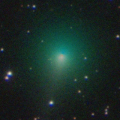
|
Now it is bright as 9.8 mag (May 14, Chris Wyatt). In the Southern Hemisphere, it keeps observable in good condition for a long time until the comet fades out. In the Northern Hemisphere, it keeps extremely low and hard to observe until June. It will be observable in good condition after June while the comet will be fading gradually.
Date(TT) R.A. (2000) Decl. Delta r Elong. m1 Best Time(A, h)
May 23 0 19.26 -1 57.9 1.712 1.452 57 9.1 3:10 (279, 9)
May 30 0 36.97 -0 8.2 1.705 1.480 59 9.3 3:05 (278, 11)
|
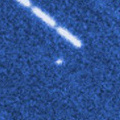
|
It brightened up to 12.8 mag until March (Mar. 21, Michael Mattiazzo). It will brighten up to 10.5 mag in May and June, but it is not observable. In the Northern Hemisphere, it will be observable after autumn while the comet will be fading.
Date(TT) R.A. (2000) Decl. Delta r Elong. m1 Best Time(A, h)
May 23 4 9.66 17 42.7 2.359 1.351 4 10.6 20:43 (129,-18)
May 30 4 32.13 20 14.7 2.361 1.349 2 10.6 20:50 (133,-18)
|
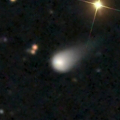
|
Now it is 12.3 mag (May 14, Chris Wyatt). It is expected to brighten up to 5 mag from autumn to winter. It keeps observable in excellent condition until autumn in the Southern Hemisphere. In the Northern Hemisphere, it is hardly observable until December.
Date(TT) R.A. (2000) Decl. Delta r Elong. m1 Best Time(A, h)
May 23 23 46.68 -24 18.5 2.947 2.867 75 11.5 3:10 (302, 2)
May 30 23 50.28 -25 26.6 2.742 2.781 81 11.2 3:05 (305, 4)
|
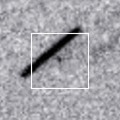
|
It will brighten up to 11 mag in April and May. But the condition is bad in this apparition. In the Southern Hemisphere, it is getting higher gradually in the morning sky. It will not be observable until late July in the Northern Hemisphere.
Date(TT) R.A. (2000) Decl. Delta r Elong. m1 Best Time(A, h)
May 23 2 9.76 1 45.5 2.406 1.639 32 11.8 3:10 (260,-11)
May 30 2 27.71 2 35.7 2.418 1.682 34 12.0 3:05 (260,-10)
|
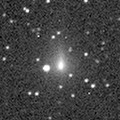
|
It brightened up to 9.5 mag from March to April (Apr. 7, Juan Jose Gonzalez). Now it is fading and getting diffuse rapidly. It has already faded down to 12.5 mag (May 7, Danil Sidorko). It seems to be a fragment of Comets C/1988 A1 (Liller) and C/1996 Q1 (Tabur). It will be fading after this, but it is observable in excellent condition in the Northern Hemisphere. In the Southern Hemisphere, it is not observable until June.
Date(TT) R.A. (2000) Decl. Delta r Elong. m1 Best Time(A, h)
May 23 11 36.73 54 31.2 1.228 1.548 86 12.8 20:43 (153, 68)
May 30 11 45.04 46 14.2 1.339 1.641 87 13.3 20:50 (128, 69)
|
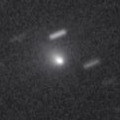
|
Now it is 12.7 mag and visible visually (May 15, Uwe Pilz). It will brighten up to 11 mag in 2015 autumn. In this apparition, it is observable until the highlight while the comet is brightening.
Date(TT) R.A. (2000) Decl. Delta r Elong. m1 Best Time(A, h)
May 23 12 20.97 5 23.4 1.448 2.153 121 13.1 20:43 ( 12, 60)
May 30 12 21.34 5 4.2 1.478 2.112 114 13.0 20:50 ( 28, 57)
|
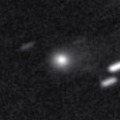
|
Now it is 14.6 mag (Apr. 25, Yuji Ohshima). In 2015, it keeps 13-14 mag and will be observable in good condition for a long time.
Date(TT) R.A. (2000) Decl. Delta r Elong. m1 Best Time(A, h)
May 23 19 27.90 -8 40.8 2.769 3.483 127 13.1 3:10 (354, 46)
May 30 19 28.40 -8 29.8 2.710 3.492 134 13.1 3:01 ( 0, 47)
|

|
Outburst occured on May 6. Now it is bright as 11.3 mag (May 16, Marco Goiato).
Date(TT) R.A. (2000) Decl. Delta r Elong. m1 Best Time(A, h)
May 23 17 49.18 -31 48.2 5.125 6.041 152 13.4 1:50 ( 0, 23)
May 30 17 45.97 -31 48.1 5.080 6.039 159 13.4 1:19 ( 0, 23)
|
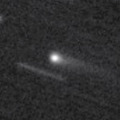
|
Now it is 14.3 mag (May 9, Yasukazu Ikari). It is expected to brighten up to 12 mag from July to August. In the Southern Hemisphere, it keeps observable in good condition until summer. In the Northern Hemisphere, it will be getting higher gradually after May, and will be observable in good condition after summer.
Date(TT) R.A. (2000) Decl. Delta r Elong. m1 Best Time(A, h)
May 23 20 54.19 -29 34.4 1.315 1.949 113 14.0 3:10 (336, 21)
May 30 20 56.50 -26 6.6 1.197 1.903 118 13.7 3:05 (339, 26)
|
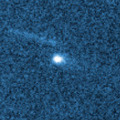
|
Now it is 15.9 mag (May 11, A. Maury, J.-G. Bosch, J.-F. Soulier, T. Noel). It will brighten up to 11 mag from August to October. In the Northern Hemisphere, it will be getting higher gradually after July, then it keeps observable in good condition. In the Southern Hemisphere, it keeps low until November.
Date(TT) R.A. (2000) Decl. Delta r Elong. m1 Best Time(A, h)
May 23 1 32.17 5 32.7 2.249 1.581 38 14.4 3:10 (262, -1)
May 30 1 52.57 7 44.3 2.177 1.534 39 14.1 3:05 (261, 0)
|
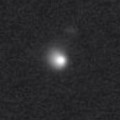
|
It brightened very rapidly. Now it is so bright as 13.8 mag and visible visually (May 11, Sandor Szabo). It keeps 14-15 mag for a while after this. In the Northern Hemisphere, it will be getting lower gradually after May, and will be unobservable in mid June. In the Southern Hemisphere, it will be getting lower gradually after June, and will be unobservable in early August.
Date(TT) R.A. (2000) Decl. Delta r Elong. m1 Best Time(A, h)
May 23 9 15.26 7 29.0 3.503 3.432 77 14.3 20:43 ( 73, 35)
May 30 9 21.87 6 56.3 3.591 3.430 72 14.3 20:50 ( 77, 29)
|

|
It brightened up to 6.9 mag in 2014 autumn (Oct. 17, Marco Goiato). Now it is fading. It has already faded down to 15.5 mag (Apr. 30, K. Hills). In the Southern Hemisphere, it keeps observable in good condition until the comet fades out. It will be observable again in mid June also in the Northern Hemisphere.
Date(TT) R.A. (2000) Decl. Delta r Elong. m1 Best Time(A, h)
May 23 0 54.65 -16 48.3 4.235 3.801 58 14.7 3:10 (286, -6)
May 30 0 55.39 -17 1.6 4.205 3.875 64 14.8 3:05 (289, -2)
|
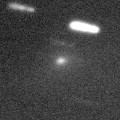
|
Now it is 14.9 mag (Apr. 17, Taras Prystavski). Distant object, but it keeps observable at 14-15 mag for a long time from 2015 to 2016.
Date(TT) R.A. (2000) Decl. Delta r Elong. m1 Best Time(A, h)
May 23 21 27.89 -1 13.6 5.340 5.559 97 15.1 3:10 (311, 42)
May 30 21 29.65 -0 59.3 5.214 5.535 103 15.0 3:05 (316, 45)
|
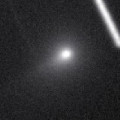
|
It brightened up to 9.2 mag in March (Mar. 9, Juan Jose Gonzalez). Now it is fading, but it is bright as 11.8 mag still now (May 16, Juan Jose Gonzalez). In the Northern Hemisphere, it will be getting higher gradually after this. It is not observable after this in the Southern Hemisphere.
Date(TT) R.A. (2000) Decl. Delta r Elong. m1 Best Time(A, h)
May 23 1 54.86 60 56.8 2.152 1.618 45 15.2 3:10 (212, 25)
May 30 2 1.64 65 31.5 2.191 1.718 49 15.7 3:05 (208, 29)
|

|
Very far object. However, outburst occured on Feb. 20, and it brightened up to 15 mag. It was reported so bright visually as 11.8 mag (Mar. 11, Marco Goiato). However, it has already faded down to 17.4 mag (Apr. 22, K. Hills). It locates high in the Southern Hemisphere. But it locates somewhat low in the Northern Hemisphere.
Date(TT) R.A. (2000) Decl. Delta r Elong. m1 Best Time(A, h)
May 23 12 0.86 -20 36.3 8.520 9.139 125 15.3 20:43 ( 13, 33)
May 30 12 0.80 -20 18.2 8.607 9.138 118 15.3 20:50 ( 22, 32)
|

|
Now it is 17.1 mag (Apr. 27, Hidetaka Sato). First return of a comet re-discovered after 112-year blank in 2008. It brightened up to 12 mag in 2008. In this apparition, it was expected to brighten up to 15 mag from spring to summer, but it is fainter than predicted. It keeps locating low in the morning sky for a while.
Date(TT) R.A. (2000) Decl. Delta r Elong. m1 Best Time(A, h)
May 23 0 33.84 8 1.8 1.970 1.540 50 15.3 3:10 (269, 12)
May 30 0 53.84 9 13.8 1.944 1.546 52 15.3 3:05 (268, 13)
|

|
Now it is 15.3 mag (Jan. 7, Taras Prystavski). It keeps 15 mag for a long time from 2014 to 2015. It is observable in excellent condition in 2014 in the Southern Hemisphere, or in 2015 in the Northern Hemisphere. It will be getting higher gradually in the morning sky.
Date(TT) R.A. (2000) Decl. Delta r Elong. m1 Best Time(A, h)
May 23 1 47.11 15 59.0 4.763 3.931 31 15.3 3:10 (252, 2)
May 30 1 52.29 17 29.4 4.713 3.941 36 15.3 3:05 (253, 6)
|
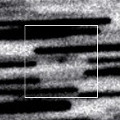
|
Now it is 17.2 mag (Apr. 24, Taras Prystavski). It is expected to brighten up to 15 mag in summer, and will be observable in excellent condition.
Date(TT) R.A. (2000) Decl. Delta r Elong. m1 Best Time(A, h)
May 23 22 41.32 -5 13.9 1.559 1.729 81 15.4 3:10 (298, 26)
May 30 22 56.05 -3 43.5 1.507 1.730 84 15.4 3:05 (298, 29)
|
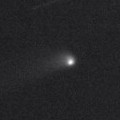
|
Now it is 15.8 mag (Feb. 22, Taras Prystavski). It will brighten up to 14 mag from 2015 to 2016. In the Southern Hemisphere, it becomes unobservable temporarily from April to May, but it will be observable in good condition again after June. It will be observable in good condition after July also in the Northern Hemisphere.
Date(TT) R.A. (2000) Decl. Delta r Elong. m1 Best Time(A, h)
May 23 3 5.25 2 46.8 5.198 4.274 21 15.4 3:10 (250,-21)
May 30 3 7.38 3 37.0 5.149 4.262 26 15.4 3:05 (253,-17)
|
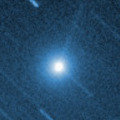
|
It brightened up to 8.2 mag in April (Apr. 8, Juan Jose Gonzalez). Now it is fading. It has already faded down to 13.2 mag (May 11, Sandor Szabo). In the Northern Hemisphere, it keeps locating high in the evening sky in May, but it will fade out rapidly after this. It is not observable in the Southern Hemisphere.
Date(TT) R.A. (2000) Decl. Delta r Elong. m1 Best Time(A, h)
May 23 7 45.60 38 37.4 1.684 1.328 52 15.4 20:43 (117, 32)
May 30 7 59.44 36 33.7 1.908 1.449 48 16.0 20:50 (117, 27)
|

|
Now it is 15.1 mag (Apr. 17, Taras Prystavski). It will pass close to the earth from spring to summer in 2016, and it is expected to be observable at 6-7 mag in good condition. It is not observable now. In the Northern Hemispehre, it will appear in the morning sky in late July, then it keeps observable in excellent condition until winter. In the Southern Hemisphere, it will be observable after mid August, but it keeps very low until winter.
Date(TT) R.A. (2000) Decl. Delta r Elong. m1 Best Time(A, h)
May 23 4 59.99 33 25.1 5.302 4.358 19 15.5 20:43 (132, 1)
May 30 5 3.48 33 29.5 5.263 4.289 14 15.4 20:50 (136, -4)
|

|
It brightened up to 11-12 mag in 2012. It has already faded down to 15.5 mag (May 11, Sandor Szabo). It keeps observable at 15 mag in good condition until summer.
Date(TT) R.A. (2000) Decl. Delta r Elong. m1 Best Time(A, h)
May 23 10 59.15 -4 38.8 9.180 9.512 106 15.6 20:43 ( 38, 43)
May 30 10 57.84 -4 24.7 9.335 9.549 99 15.6 20:50 ( 48, 38)
|

|
Now it is 14.7 mag (Apr. 1, Taras Prystavski). It is observable at 15-16 mag in good condition in 2015.
Date(TT) R.A. (2000) Decl. Delta r Elong. m1 Best Time(A, h)
May 23 18 41.02 -20 40.7 6.952 7.772 141 15.6 2:41 ( 0, 34)
May 30 18 36.51 -21 5.2 6.912 7.802 149 15.6 2:09 ( 0, 34)
|

|
It has not been observed yet in this apparition. But it must have already brightened up to 16 mag. It will be observable at 13 mag in good condition from summer to autumn. It was fainter than 17.5 mag on Apr. 24 (Taras Prystavski).
Date(TT) R.A. (2000) Decl. Delta r Elong. m1 Best Time(A, h)
May 23 23 3.18 -10 35.0 1.785 1.870 78 15.9 3:10 (298, 19)
May 30 23 19.09 -9 18.9 1.703 1.843 81 15.6 3:05 (298, 21)
|
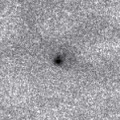
|
It must have brightened up to 11 mag from January to February, but no observations have been reported. Now it is 15.6 mag (Apr. 24, Taras Prystavski). In the Southern Hemisphere, it is observable in the morning sky after this while the comet will be fading. In the Northern Hemisphere, it will be getting higher after July, but the comet will be faitner than 17 mag.
Date(TT) R.A. (2000) Decl. Delta r Elong. m1 Best Time(A, h)
May 23 1 5.93 -11 18.6 2.221 1.798 52 15.7 3:10 (280, -5)
May 30 1 20.25 -10 40.8 2.221 1.851 55 15.8 3:05 (280, -4)
|
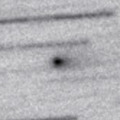
|
Now it is bright as 13.9 mag and visible visually (May 14, Chris Wyatt). In this apparition, it turns to approach to the sun down to 1.17 a.u., and it was expected to brighten up to 13 mag from March to May. But actually, it brightened up to 14-15 mag at best. It will be fading after this.
Date(TT) R.A. (2000) Decl. Delta r Elong. m1 Best Time(A, h)
May 23 21 11.31 -9 9.2 0.496 1.229 103 15.9 3:10 (321, 37)
May 30 21 24.32 -8 5.5 0.504 1.257 107 16.0 3:05 (323, 40)
|

|
It approached to the earth, and brightened up to 12.0 mag from April to May (Apr. 24, Taras Prystavski). However, it will be fading after this, and will be fainter than 18 mag in late July. It is observable in excellent condition in the Southern Hemisphere. It will be observable in excellent condition after May also in the Northern Hemisphere.
Date(TT) R.A. (2000) Decl. Delta r Elong. m1 Best Time(A, h)
May 23 21 52.98 1 11.3 0.750 1.265 90 15.9 3:10 (303, 39)
May 30 22 1.43 7 32.9 0.768 1.300 92 16.1 3:05 (300, 46)
|
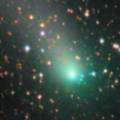
|
It brightened up to 9 mag from autumn to winter in 2014. Now it is fading rapidly. It has already faded down to 15.0 mag (May 9, Yasukazu Ikari). In the Northern Hemisphere, it will be observable in excellent condition after this while the comet will be fading. In the Southern Hemisphere, it is hardly observable after this.
Date(TT) R.A. (2000) Decl. Delta r Elong. m1 Best Time(A, h)
May 23 13 48.57 55 44.0 2.762 3.089 99 16.0 21:44 (180, 69)
May 30 13 29.22 54 28.1 2.906 3.161 95 16.3 20:57 (180, 71)
|

|
It brightened up to 13 mag in winter. Now it is fading. It has already faded down to 16.0 mag (May 5, Yasukazu Ikari). It keeps observable in good condition for a while.
Date(TT) R.A. (2000) Decl. Delta r Elong. m1 Best Time(A, h)
May 23 11 22.28 14 6.1 2.300 2.731 104 16.0 20:43 ( 47, 62)
May 30 11 26.85 13 1.1 2.421 2.768 99 16.2 20:50 ( 56, 56)
|

|
It brightened up to 13 mag in 2014. Now it is 15.5 mag (Jan. 3, Ken-ichi Kadota). It will be fading slowly after this. It is observable at 16 mag in excellent condition from summer to winter in 2015.
Date(TT) R.A. (2000) Decl. Delta r Elong. m1 Best Time(A, h)
May 23 0 52.03 -1 30.6 4.188 3.626 50 16.2 3:10 (274, 3)
May 30 0 58.87 -0 51.2 4.125 3.642 55 16.2 3:05 (275, 6)
|
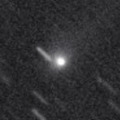
|
Now it is 15.8 mag (May 11, Catalina Sky Survey). In the Northern Hemisphere, it keeps 15-16 mag and observable in excellent condition until early summer. It locates somewhat low in the Southern Hemisphere.
Date(TT) R.A. (2000) Decl. Delta r Elong. m1 Best Time(A, h)
May 23 12 40.97 26 53.7 3.536 4.040 112 16.3 20:43 ( 7, 82)
May 30 12 40.22 25 30.1 3.645 4.072 107 16.4 20:50 ( 44, 77)
|

|
First return of a periodic comet discovered in 1994. Now it is 17.5 mag (Mar. 23, iTelescope Observatory, Siding Spring). It will brighten up to 15 mag from summer to autumn, and will be observable in excellent condition in the Southern Hemisphere. It locates somewhat low in the Northern Hemisphere.
Date(TT) R.A. (2000) Decl. Delta r Elong. m1 Best Time(A, h)
May 23 22 18.82 -32 3.7 2.498 2.797 96 16.7 3:10 (321, 10)
May 30 22 27.68 -32 3.8 2.393 2.768 100 16.5 3:05 (323, 11)
|

|
Now it is 17.8 mag (Apr. 25, Yasukazu Ikari). It will brighten rapidly, and will be observable at 16.5 mag in good condition from May to July.
Date(TT) R.A. (2000) Decl. Delta r Elong. m1 Best Time(A, h)
May 23 16 29.64 -15 11.5 0.808 1.815 170 16.6 0:30 ( 0, 40)
May 30 16 27.09 -13 29.7 0.791 1.800 171 16.5 0:00 ( 0, 41)
|

|
It brightened up to 10.6 mag from autumn to winter (Nov. 29, Seiichi Yoshida). Now it is fading. It has already faded down to 15.4 mag (Apr. 20, Taras Prystavski). It keeps observable for a long time until the comet fades out.
Date(TT) R.A. (2000) Decl. Delta r Elong. m1 Best Time(A, h)
May 23 17 16.70 -15 9.8 1.852 2.825 160 16.7 1:17 ( 0, 40)
May 30 17 9.86 -15 20.8 1.900 2.898 167 16.9 0:43 ( 0, 40)
|

|
Now it is 17.7 mag (Feb. 17, K. Hills). It keeps observable at 17 mag from spring to summer. It locates somewhat low in the Northern Hemisphere.
Date(TT) R.A. (2000) Decl. Delta r Elong. m1 Best Time(A, h)
May 23 17 8.48 -27 47.9 2.194 3.173 162 16.7 1:09 ( 0, 27)
May 30 17 3.78 -27 24.0 2.176 3.178 169 16.7 0:37 ( 0, 28)
|

|
First return of a periodic comet discovered in 2008. Now it is 19 mag (Apr. 5, WISE). It will approach to the earth from spring to summer, and brighten rapidly. It will brighten up to 16 mag, and will be observable in good condition.
Date(TT) R.A. (2000) Decl. Delta r Elong. m1 Best Time(A, h)
May 23 22 1.59 -6 17.6 0.794 1.299 91 16.9 3:10 (307, 33)
May 30 22 33.35 -5 50.3 0.756 1.267 90 16.7 3:05 (305, 31)
|

|
Getting observable again in the morning sky. It is fading, but it is observable at 17 mag in good condition until late autumn.
Date(TT) R.A. (2000) Decl. Delta r Elong. m1 Best Time(A, h)
May 23 23 47.60 13 6.5 6.113 5.672 59 16.8 3:10 (271, 24)
May 30 23 48.53 12 59.9 6.052 5.717 66 16.8 3:05 (274, 29)
|
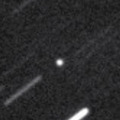
|
Now it is 16.3 mag (May 12, J. Lozano). It keeps observable after this while the comet will be getting brighter graudually. It will brighten up to 11 mag from autumn to winter. But it locates low at that time.
Date(TT) R.A. (2000) Decl. Delta r Elong. m1 Best Time(A, h)
May 23 14 9.51 7 53.0 1.320 2.202 141 16.8 22:06 ( 0, 63)
May 30 14 3.86 7 42.5 1.323 2.159 134 16.9 21:33 ( 0, 63)
|

|
It brightened rapidly in outburst in mid October in 2013, then it keeps bright as 8-10 mag for a long time until 2014 summer. Now it is fading. It has already faded down to 15.8 mag (Feb. 9, Taras Prystavski). In the Southern Hemisphere, it keeps observable in good condition for a long time after this until the comet fades out. It is not observable in the Northern Hemisphere.
Date(TT) R.A. (2000) Decl. Delta r Elong. m1 Best Time(A, h)
May 23 1 18.16 -32 4.9 5.685 5.334 64 16.9 3:10 (296,-19)
May 30 1 23.54 -32 20.4 5.669 5.394 69 16.9 3:05 (298,-16)
|

|
Now it is 17.5 mag (Apr. 27, Hidetaka Sato). It will be observable at 15 mag in good condition in autumn.
Date(TT) R.A. (2000) Decl. Delta r Elong. m1 Best Time(A, h)
May 23 23 59.42 0 28.2 2.649 2.338 61 17.0 3:10 (280, 15)
May 30 0 11.48 1 33.8 2.558 2.317 64 16.9 3:05 (281, 17)
|
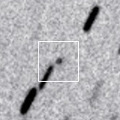
|
Now it is 16.5 mag (May 1, R. A. Mastaler, A. F. Tubbiolo). It keeps 17 mag until summer.
Date(TT) R.A. (2000) Decl. Delta r Elong. m1 Best Time(A, h)
May 23 20 32.98 20 40.9 1.590 2.041 101 17.1 3:10 (303, 67)
May 30 20 6.26 24 43.6 1.503 2.069 109 17.0 3:05 (322, 77)
|
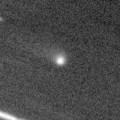
|
Now it is 16.3 mag (Apr. 19, Catalina Sky Survey). It keeps 17 mag for a long time from 2014 to 2016.
Date(TT) R.A. (2000) Decl. Delta r Elong. m1 Best Time(A, h)
May 23 10 49.61 -16 45.4 5.027 5.422 107 17.0 20:43 ( 33, 31)
May 30 10 45.77 -16 9.6 5.154 5.431 100 17.1 20:50 ( 42, 27)
|
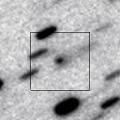
|
Now it is 16.4 mag (Apr. 22, M. Jaeger, W. Vollmann, E. Prosperi, S. Prosperi). It keeps 17 mag until July. It is observable in excellent condition in the Southern Hemisphere. It locates somewhat low in the Northern Hemisphere.
Date(TT) R.A. (2000) Decl. Delta r Elong. m1 Best Time(A, h)
May 23 16 30.52 -23 53.3 1.566 2.572 171 17.1 0:31 ( 0, 31)
May 30 16 24.99 -23 50.0 1.565 2.578 177 17.1 23:54 ( 0, 31)
|
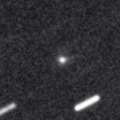
|
Now it is 17.4 mag (May 8, M. Morales). It will brighten up to 14 mag and will be observable in good condition in 2016.
Date(TT) R.A. (2000) Decl. Delta r Elong. m1 Best Time(A, h)
May 23 12 29.29 3 37.9 2.896 3.559 123 17.2 20:43 ( 8, 58)
May 30 12 28.73 3 36.5 2.949 3.525 116 17.2 20:50 ( 24, 56)
|
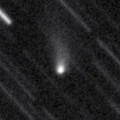
|
It brightened up to 15.3 mag in winter (Jan. 17, Taras Prystavski). Now it is fading. It is observable in good condition in the Southern Hemisphere. It will be observable in good condition after June also in the Northern Hemisphere.
Date(TT) R.A. (2000) Decl. Delta r Elong. m1 Best Time(A, h)
May 23 0 56.29 -20 38.0 2.567 2.245 60 17.4 3:10 (289, -9)
May 30 0 53.98 -19 39.5 2.497 2.284 66 17.4 3:05 (291, -4)
|
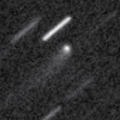
|
Now it is 17.4 mag (Apr. 14, A. Klotz, F. Kugel, J. Nicolas, C. Rinner). It keeps observable at 17-18 mag for a long time from 2013 to 2016. It keeps locating high in the Northern Hemisphere. It keeps locating very low in the Southern Hemipshere.
Date(TT) R.A. (2000) Decl. Delta r Elong. m1 Best Time(A, h)
May 23 15 38.18 65 53.8 6.587 6.727 93 17.4 23:33 (180, 59)
May 30 15 23.28 65 53.0 6.634 6.740 91 17.4 22:51 (180, 59)
|

|
Now it is 17.9 mag (Mar. 21, W. Hasubick). It was observed at 17 mag in 2014 summer. In the Northern Hemisphere, it is observable at 17.5 mag in excellent condition also in 2015. It is not observable in the Southern Hemisphere.
Date(TT) R.A. (2000) Decl. Delta r Elong. m1 Best Time(A, h)
May 23 22 5.33 49 4.6 4.364 4.188 73 17.4 3:10 (232, 55)
May 30 22 10.22 50 4.4 4.343 4.212 75 17.4 3:05 (230, 58)
|

|
First return of a new periodic comet which brightened up to 12 mag in 2009. It seems to brighten up to 17 mag in summer. It is observable in good condition in the Southern Hemisphere. In the Northern Hemisphere, it keeps locating extremely low after June.
Date(TT) R.A. (2000) Decl. Delta r Elong. m1 Best Time(A, h)
May 23 9 39.10 -6 22.1 1.393 1.694 88 17.7 20:43 ( 56, 30)
May 30 9 51.57 -6 17.5 1.410 1.657 84 17.5 20:50 ( 60, 26)
|
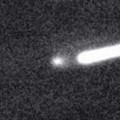
|
It brightened up to 15.5 mag from autumn to winter (Nov. 25, Taras Prystavski). Now it is fading. It has already faded down to 17.7 mag (Apr. 28, A. Diepvens). It keeps observable in good condition for a while.
Date(TT) R.A. (2000) Decl. Delta r Elong. m1 Best Time(A, h)
May 23 17 48.28 -8 8.0 1.630 2.560 150 17.7 1:49 ( 0, 47)
May 30 17 42.98 -8 15.1 1.640 2.603 156 17.8 1:16 ( 0, 47)
|

|
It has not been observed since 2005. It is expected to brighten up to 11 mag from summer to autumn. In the Northern Hemisphere, it keeps observable in good condition in the morning sky. It keeps locating extremely low from summer to autumn.
Date(TT) R.A. (2000) Decl. Delta r Elong. m1 Best Time(A, h)
May 23 21 58.86 0 23.4 1.243 1.595 89 18.3 3:10 (302, 38)
May 30 22 18.54 3 39.4 1.127 1.519 90 17.7 3:05 (300, 41)
|
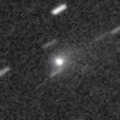
|
It Brightened up to 15.2 mag and visible visually in March (Mar. 18, Sandor Szabo). Now it is fading. It has already faded down to 16.6 mag (Apr. 27, Mitsunori Tsumura). It keeps observable in good condition for a while.
Date(TT) R.A. (2000) Decl. Delta r Elong. m1 Best Time(A, h)
May 23 11 52.51 9 45.5 2.034 2.600 112 17.7 20:43 ( 29, 62)
May 30 11 56.35 9 2.5 2.145 2.630 107 17.9 20:50 ( 41, 58)
|

|
Now it is 17.7 mag (May 10, A. Maury, J.-F. Soulier). It has brightened in outburst up to 14 mag twice, in 2006 January and 2011 May. It passes the perihelion in 2015. It keeps observable at 17 mag for a long time after this.
Date(TT) R.A. (2000) Decl. Delta r Elong. m1 Best Time(A, h)
May 23 23 15.92 -3 36.0 6.035 5.819 72 17.9 3:10 (290, 21)
May 30 23 19.11 -3 17.3 5.932 5.820 78 17.8 3:05 (293, 25)
|

|
Now it is 19.2 mag (Mar. 22, iTelescope Observatory, Siding Spring). It will be observable at 17.5 mag in good condition in summer.
Date(TT) R.A. (2000) Decl. Delta r Elong. m1 Best Time(A, h)
May 23 23 35.29 -0 48.7 1.649 1.568 67 18.0 3:10 (285, 19)
May 30 23 54.62 0 41.2 1.603 1.561 69 17.9 3:05 (284, 20)
|

|
It had been observed at 15 mag for a long time from 2013 to 2014. Now it is fading. It will be observable at 18 mag in good condition from spring to summer. It locates somewhat low in the Northern Hemisphere.
Date(TT) R.A. (2000) Decl. Delta r Elong. m1 Best Time(A, h)
May 23 19 35.08 -29 50.0 4.461 5.172 130 17.9 3:10 (354, 25)
May 30 19 33.35 -30 4.3 4.404 5.194 137 17.9 3:05 ( 0, 25)
|
|
![]()
 C/2014 N3 ( NEOWISE )
C/2014 N3 ( NEOWISE ) 57P/du Toit-Neujmin-Delporte
57P/du Toit-Neujmin-Delporte C/2014 A4 ( SONEAR )
C/2014 A4 ( SONEAR ) C/2015 F5 ( SWAN-Xingming )
C/2015 F5 ( SWAN-Xingming ) C/2013 X1 ( PanSTARRS )
C/2013 X1 ( PanSTARRS ) C/2006 S3 ( LONEOS )
C/2006 S3 ( LONEOS ) C/2010 S1 ( LINEAR )
C/2010 S1 ( LINEAR ) 51P/Harrington
51P/Harrington 7P/Pons-Winnecke
7P/Pons-Winnecke 218P/LINEAR
218P/LINEAR C/2015 F2 ( Polonia )
C/2015 F2 ( Polonia ) C/2013 A1 ( Siding Spring )
C/2013 A1 ( Siding Spring ) 32P/Comas Sola
32P/Comas Sola 117P/Helin-Roman-Alu 1
117P/Helin-Roman-Alu 1 C/2013 V2 ( Borisov )
C/2013 V2 ( Borisov ) 318P/2014 M6 ( McNaught-Hartley )
318P/2014 M6 ( McNaught-Hartley ) 221P/LINEAR
221P/LINEAR C/2014 R1 ( Borisov )
C/2014 R1 ( Borisov ) 299P/2014 D2 ( Catalina-PanSTARRS )
299P/2014 D2 ( Catalina-PanSTARRS ) 319P/2015 G1 ( Catalina-McNaught )
319P/2015 G1 ( Catalina-McNaught ) C/2011 J2 ( LINEAR )
C/2011 J2 ( LINEAR ) 10P/Tempel 2
10P/Tempel 2 C/2012 X1 ( LINEAR )
C/2012 X1 ( LINEAR ) 61P/Shajn-Schaldach
61P/Shajn-Schaldach C/2015 H1 ( Bressi )
C/2015 H1 ( Bressi ) C/2013 G9 ( Tenagra )
C/2013 G9 ( Tenagra ) P/2015 F1 ( PanSTARRS )
P/2015 F1 ( PanSTARRS ) 53P/Van Biesbroeck
53P/Van Biesbroeck C/2014 AA52 ( Catalina )
C/2014 AA52 ( Catalina ) C/2012 K8 ( Lemmon )
C/2012 K8 ( Lemmon ) C/2013 G3 ( PanSTARRS )
C/2013 G3 ( PanSTARRS ) P/2009 L2 ( Yang-Gao )
P/2009 L2 ( Yang-Gao ) 40P/Vaisala 1
40P/Vaisala 1 141P/Machholz 2
141P/Machholz 2 70P/Kojima
70P/Kojima 174P/(60558) 2000 EC98 ( Echeclus )
174P/(60558) 2000 EC98 ( Echeclus ) 220P/McNaught
220P/McNaught P/2012 B1 ( PanSTARRS )
P/2012 B1 ( PanSTARRS )![]()















































